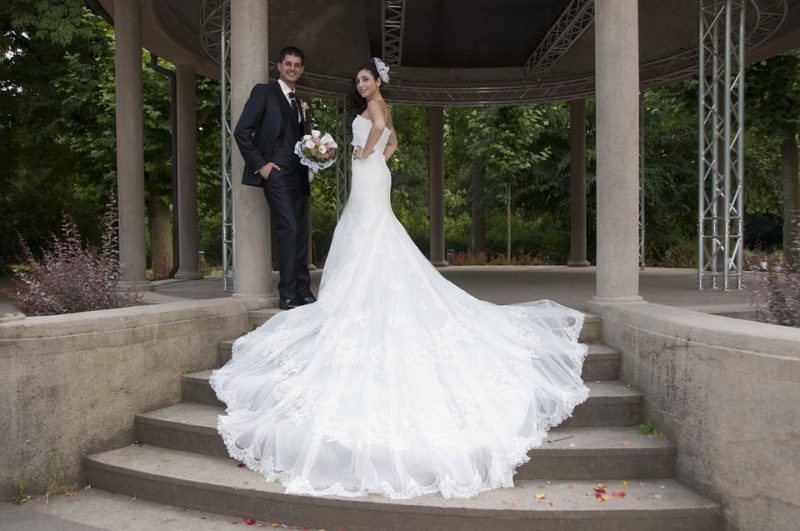It’s easy to learn how to make a detachable train for a wedding dress because it’s only three steps. This tutorial will help you with the measurement, assembly, and how you can put on a detachable wedding dress train.
You can also read how to bustle a wedding dress with a tulle overlay. Instead of removing the train, bustling will transform the wedding dress into a regular train-free dress for the reception after the ceremony.

How To Make A Detachable Train For A Wedding Dress Yourself
Step 1. Preparation and measurement
- Wear your wedding dress; at this point, the dress should already be altered accordingly as you’ll be assuming that it will be the final look for the wedding day
- Make sure that you’ll also be wearing the undergarments and shoes you intend to wear on your wedding day to avoid errors in the measurement of the train
- Have a friend measure the distance of your waist to the floor, then add the length you want for your train; the final size will be the amount of fabric you’ll need but allocate some excess for allowance
- Once you have the fabric length, hold the train against your waist to identify the width you would like for it
Step 2. Construction of the detachable wedding dress train
- Consider between hand-sewing or machine-sewing your detachable wedding train according to the type of fabric you’re using; the more delicate the material is, the better it will be to be hand-stitched
- Please start with the train width by sewing long stitches along an inch from the top of the train; add another row of stitches underneath this first row for added security and pull the thread ends to gather the top until it reaches the ideal train width
- Tie the thread ends for security and work on the details that will make the train detachable
- Prepare a piece of ribbon and sew it across the top of the train, then attach snaps underneath it
- Measure the pairing of snaps accordingly as the other side of these closures will be on the dress waistline to receive the ones on the ribbon
Step 3. Finishing and adjustment of the detachable train
- If the snaps on the detachable train are too evident for your liking, you can cover them with embellishments such as pearls or studs
- Prepare the train lining by cutting it according to the same length as the train; you want a fabric that will enhance the train’s durability but will also remain flowy to glide on the aisle
- Sew the lining to the train with consistent stitches and backstitch for added strength
- Make the necessary adjustments for the size and shape of the train
- Embellish the train if needed so it won’t look out of place against the wedding dress; use the dress’ current style as inspiration, whether it’s adding lace, beads, pearls, or sequins
- Recheck the effectiveness and strength of the snaps and how the train looks when attached to the dress to finish
- Practice walking with the dress train to know if you must add other closures
- Practice removing the dress train to ensure that it won’t damage the dress
Can You Make A Wedding Dress Train Detachable?
You can make a wedding dress train detachable by adding closures to it. This will help the train attach to the dress waist but remain removable for better mobility after the wedding ceremony.
Opt for a Watteau train
Another option for brides is to opt for a Watteau-style wedding dress train. Unlike a traditional wedding train, a Watteau train attaches to your upper back or shoulder like a cape.
You’ll still have the classic bridal look with a trailing fabric behind you, but you can easily remove it when needed than those sewn to the waist. But if you have a specific train style that you genuinely want, then ask the seamstress at the bridal shop to bustle it for you.
Consider bustling the train
Your seamstress will talk to your maid of honor or any close friend that will help you bustle the train before the reception. You can’t do it yourself because you’ll be wearing the dress.
Sewists have different ways of bustling the train. Regardless, it’s decoratively shortening the train length, so the dress looks like it doesn’t have a train.
Which Material Is Best For Bridal Train?
Organza
One of the most common fabrics for bridal trains is organza. It has more structure than chiffon, and you can use it to overlay trains because of its lightness.
Silk Faille
Silk Faille will make an excellent bridal train. You can combine it with tulle and lace for a graceful and elegant train.
Georgette
A classic bridal train is something sheer and floats effortlessly. You can consider the Georgette fabric made from silk as an overlay or embellishment for this look.
Are you curious why do wedding dresses have trains? Read about its history to help you consider if you must follow the tradition or not.
Conclusion
And that’s it! You’ve just learned how to make a detachable train for a wedding dress in three steps.
Start by measuring the ideal size of the train, then sew snaps to it to attach it to the dress waist. Embellish the train according to finish, but make sure to check the quality of the stitches when removing and installing the train.
